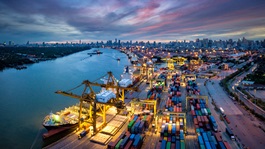
Publication
Navigating international trade and tariffs
Impacts of evolving trade regulations and compliance risks

Global | Publication | September 2017
This article first appeared in Recharge.
The allocation of contracts for difference (CfDs) under the second allocation round (AR2), while fundamentally positive for the UK’s renewable market, was a mixed bag.
There was little doubt that offshore wind would take a significant proportion of the budget available, but perhaps less anticipated was just how low the strike price would go, with reductions of up to 50% seen compared to the first allocation round held in 2015.
Notable by their absence from the results, the UK’s nascent energy classes such as wave and tidal stream may have to face some potentially stark realities.
Looking at offshore wind first, the results have given the sector a significant boost. Amongst the technologies participating in AR2, the offshore wind sector is a comparatively mature one, and one which in recent years has seen decreasing costs of capital driven by greater competition, improvements in the UK supply chain and the adoption of larger turbines.
The AR2 results follow closely from tenders in Germany, the Netherlands and Denmark which have already experienced an acute downward trend in support levels with some reaching zero tariffs.
Whilst the UK market is not directly comparable because of differences in the development of sites and grid connection arrangements, the prices seen in AR2 are nevertheless indicative of significant efficiency savings in the sector. The industry has taken on board the clear message from government that while renewables should play a significant part in the UK’s energy generation mix, in particular to help achieve its carbon emissions reduction commitments, less is more when it comes to consumers’ contribution to the costs.
For some less established technologies such as wave and tidal stream, the results are less promising, at least in the short term: to compete in the same technology ‘pot’ as offshore wind, these less mature technologies will need to find a way to compete on costs to be able to pick up a larger piece of the CfD pie, something achieved only by advanced conversion technologies and dedicated biomass projects with CHP in AR2.
Although floating offshore wind was not part of the CfD auction, that technology will similarly be considering how to move from demonstration projects to commercialisation.
The challenge for the UK government will now be to maximise the economic opportunities which the offshore wind supply chain presents for UK business with many in the industry already calling for details on further auctions.
Visibility on the future project pipeline could turn out to be a significant factor in capitalising on the AR2 results as markets develop in Asia and the US for offshore wind, which might present more attractive prospects for developers and the offshore wind supply chain. When compared with UK projects to date, the relative speed at which these jurisdictions bring projects online, may be a defining factor for many.
While UK offshore wind has proved itself to be the standout winner in AR2, the UK renewable energy industry will now be looking to government for leadership on the future of the wider renewables market with the publication of the Clean Growth Plan and a cost of energy review expected later this year.

Publication
Impacts of evolving trade regulations and compliance risks

Publication
As the UK’s Office of Financial Sanctions Implementation (OFSI) proposes reforms to its civil enforcement processes for financial sanctions and geopolitical developments impacting sanctions regimes continue at pace, sanctions remain a key area of focus not only for UK regulators in the context of enforcement, but also in a number of cases before the English Courts.
Subscribe and stay up to date with the latest legal news, information and events . . .
© Norton Rose Fulbright LLP 2025